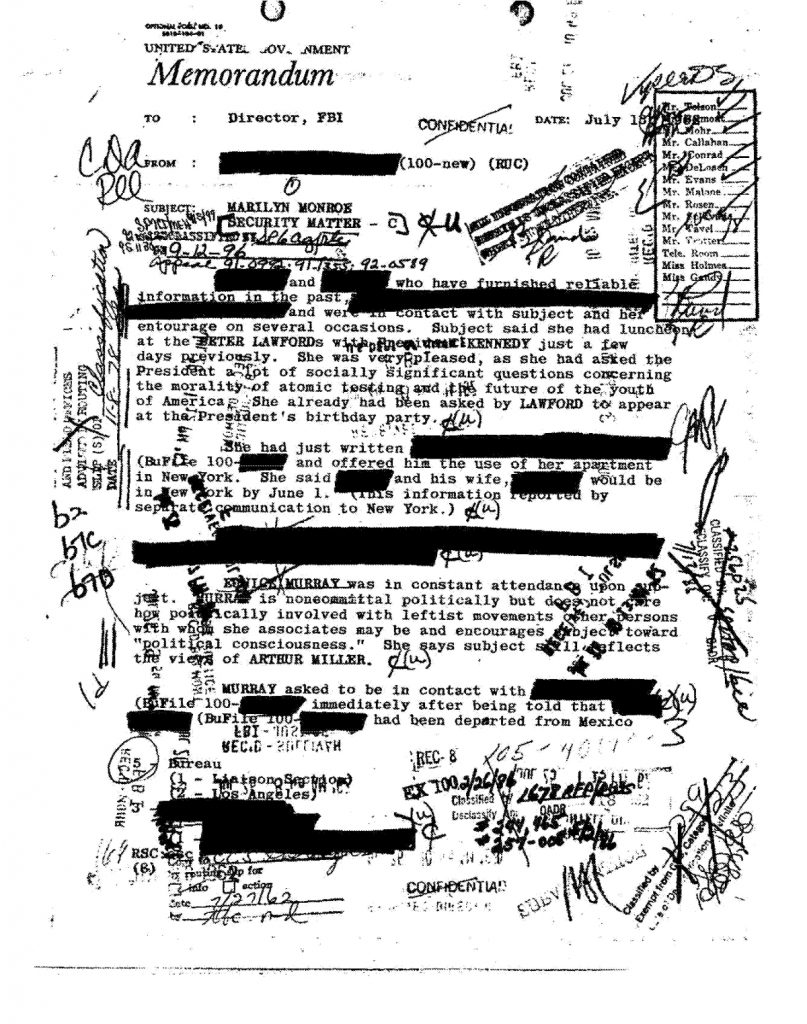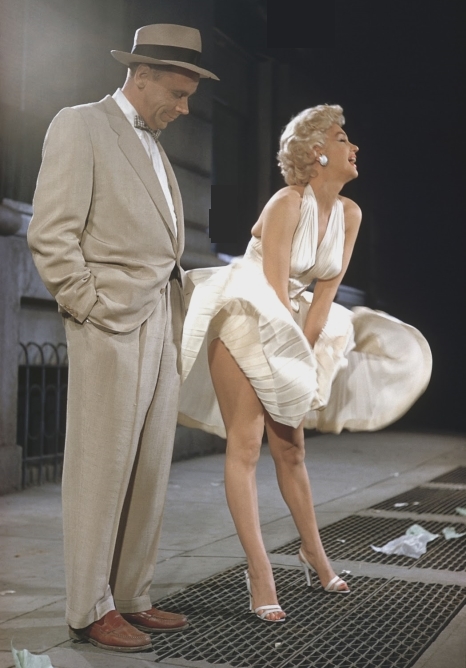The Intelligence Files
President Lyndon Johnson signed the Freedom of Information Act, the FOIA, into law on July the 4th in 1966. What Johnson signed was actually an amendment to Section 3 of the Administrative Procedure Act of 1946. The FOIA has been modified frequently over the passing years, occasionally narrowed, occasionally expanded, always on executive order issued by subsequent presidents. Johnson’s amendment intended to give the American people unfettered access to information contained in the documents and records held by their government; however, some historians, journalists and writers claim the law has not given them unfettered access to anything except stonewalling by various federal agencies, particularly Hoover’s Federal Bureau and the inscrutable Central Intelligence Agency.
The year the FBI and CIA actually began to declassify their surveillance reports and memoranda regarding Marilyn Monroe is unknown to me. It is also unknown to me when the first FOIA forms requesting the release of a Marilyn surveillance report appeared in the halls of the central bureaucracy; but as the files became declassified, historians, novelists, conspiracists and potential biographers, journalists and a curious citizenry wanted to read the information thereon. What secrets about Marilyn’s life might be gleaned from those cryptic and mysterious government files? What details about her death might be discovered? Certainly, a few of the curious simply hoped to discover some new tantalizing and lurid detail that could be fitted into a new conspiracy theory or a new novel biographical novel. Would the world finally learn the facts about the persons involved in Marilyn’s death? Would confirmation be forthcoming, confirmation of what most of the world already believed, that the second most discussed, the second most analyzed death of the 20th century was a premeditated murder, both perpetrated and obscured by the nation’s two most powerful men, both of whom were subsequently murdered? What the curious hoped to discover or confirm notwithstanding, what did, and what do, the files and documents declassified and released by the FBI and the CIA actually reveal about Marilyn Monroe’s life and her unsettling untimely death?
Heavily redacted and censored, some of the released documents have been rendered unintelligible by their redaction and some of the copies are so poor they are virtually illegible. Often it is difficult to discern the original date of composition: they are literally covered with dated and initialed stamps of classification and declassification, not to mention a scrawl of undated initials apparently inscribed by federal bureau employees, agents and bureaucrats who read the reports and memoranda as the years passed. Frankly, the memoranda and reports are replete with humorous errors and are, by and large, gossipy and often approach the boring; but the FBI’s interest in Marilyn’s political life began in 1955, generally coincident with the romantic relationship she began with the playwright Arthur Miller, a known leftist and communist sympathizer, according to J. Edgar Hoover.
Marilyn was a true disciple of Konstantin Stanislavski, the Russian thespian who co-founded the Moscow Art Theater and developed an acting grammar which eventually became known as his system, later adapted by Lee Strasberg into his method. During the summer 1955, Marilyn traveled to Belmont, Illinois, where she presided over an art museum’s opening, delivered a speech about Abraham Lincoln, her favorite president, and judged a best beard contest that featured some hairy residents of Belmont. While there, she was approached by the President of the National Arts Foundation, Carlton Smith, who asked if she might consider leading a trip to Moscow for an acting colloquy and a cultural exchange between the competing nations and political ideologies. Marilyn accepted immediately and began the process of obtaining a visa through the Russian Embassy.
On October the 11th, she attended a performance at Carnegie Hall by the Russian pianist, Emil Gilels. After being introduced to Marilyn, he extended an invitation for her to visit Russia, stating that the Russian people would love to see her: after all, to the Russian people, America was Coca Cola, Mickey Mouse and Marilyn Monroe. Marilyn indicated that she intended to visit Russia, soon. It has been reported that Hoover ordered Marilyn’s movements closely monitored; he wanted immediate notification if she attempted to travel to Moscow. Marilyn had an affinity for the Russian culture due to her devotion to her Russian acting teacher, Michael Chekhov, and Konstantin Stanislavski. Marilyn’s association with Natasha Lytess and Joe Schenck, both Russian immigrants and both of whom told her interesting and exciting stories about Russia, engendered a desire in her to travel there.
The classified memoranda and letters which passed between J. Edgar Hoover and Dennis A. Flinn, Director, Office of Security, Department of State, copies of which were also routed to the Assistant Attorney General, William F. Tompkins, indicated that the FBI, the state department and other officials in the central bureaucracy were particularly troubled by Marilyn’s request for a visa application from the Russian Embassy. Those documents were the first to deal with what the fifty’s bureaucrats considered to be Marilyn’s questionable and anti-American activities; but those documents certainly would not be the last.
By 1956, apparently an overly paranoid Hoover was convinced that Marilyn intended to defect to the dark side, since she was, by then, under the influence of both Arthur Miller and Lee Strasberg, both confirmed leftists; and for a time, Hoover even fretted over Milton and Amy Greene, concerned that they, too, were communists. Hoover, of course, was particularly interested in Arthur Miller and his allegedly sinister Communist shenanigans. Miller’s plays espoused leftist and Communist ideals and he associated with known Communist groups and other Communist sympathizers, like Elia Kazan.
The playwright had already captured the attention of Hoover and the FBI prior to his introduction to Marilyn by Kazan in 1951. Both men were being monitored by Hoover, even before Marilyn began her relationships with them; and when Marilyn married Arthur during the summer of 1956, the FBI’s interest in her increased dramatically. An Office Memorandum, United States Government, dated the 13th of February in 1956, written by A.H. Belmont, whom I identified in the previous section, to L.V. Boardman, referenced a Walter Winchell broadcast which had aired the day before. Winchell declared: Broadway! And the fact that America’s best known blonde moving picture star is now the darling of the left-wing intelligentsia, several of whom are listed as red fronters, I do not think she realizes it. The FBI memorandum then commented:
This possibly refers to Marilyn Monroe. A recent news article covering the divorce action between Arthur Asher Miller, prominent author, and his wife, reflected it was rumored Marilyn Monroe was linked romantically with Miller. On interview by newsmen both of them admitted friendship but denied any romantic ties. Miller is the author of “Death of a Salesman” [large redaction]. We have not conducted an security investigation concerning Marilyn Monroe.
A perceptive fellow could only conclude that, not long thereafter, the FBI conducted their Marilyn Monroe security investigation.
There are several files and reports dedicated to Arthur Miller’s divorce from Mary Slattery, his romantic involvement with Marilyn and his appearance before the House Un-American Activities Committee. One report even confirmed that Miller had established the necessary six-weeks residence for divorce at the Pyramid Lake Guest Ranch near Reno. I, for one, was surprised to learn that the Federal Bureau was interested in such mundane details about the lives of American citizens. Another report noted that The Daily Worker, an East Coast Communist daily newspaper, published an article on July the 10th in 1956 memorializing that Arthur Miller and actress Marilyn Monroe would fly to England on Friday (July 13, 1956) on a honeymoon and business trip. Another report from 1956 indicated that
the New York Daily News received an anonymous telephone call from an unidentified male during which he stated that Arthur Miller had been and still was a member of the CP and was their cultural front man […] and according to the anonymous caller, Marilyn Monroe had drifted into the Communist orbit and money from Marilyn Monroe Productions was finding its way into the CP. This source stated that Marilyn Monroe Productions was filled with Communists.
An office memorandum dated October the 11th in 1956 announced: Subject Miller is the new husband of Marilyn Monroe, a full five months after Marilyn and Miller were married. The FBI agents who wrote those reports marked them as either secret, confidential or classified even though the information thereon was common knowledge and appeared in virtually every newspaper across the county,1On July the 1st in 1956, at 10:30 PMET, Judge Seymour Rabinowitz appeared on the popular television program, What’s My Line. Judge Rabinowitz had married Marilyn and Arthur Miller on June the 29th in White Plains, New York. On the day of the program, Marilyn and Arthur were married a second time in a Jewish ceremony. Obviously their marriage was not a secret.
<https://www.youtube.com/watch?v=TwF026C0i6g>perhaps even the globe, with the possible exception being that Marilyn’s production company was filled to the brim with nefarious Communists funneling money to the Communist Party. Marilyn Monroe Productions was by and large a two person organization consisting of Marilyn and Milton Greene. Marilyn was the major stock holder and president while Milton Greene was the minority stock holder and vice-president. The production company did not earn any money upon its inception and never earned what might be called a fortune or enough money to funnel funds to the Communist Party.
Fast forward six short years to a time in 1962 when Marilyn was no longer married to Arthur Miller; but even so, the FBI still followed her activities closely, as attested by the FBI’s interest in Marilyn’s trip to Mexico that year. On the 12th of February, Eunice Murray, Marilyn’s housekeeper, traveled to Mexico City. Her task was to reconnoiter for appropriate shops in which Marilyn could buy authentic Mexican items, furniture, art work and knick knacks, for her recently purchased hacienda in Brentwood. Mrs. Murray also visited her brother-in-law, Churchill Murray, while waiting for Marilyn to arrive.
Meanwhile, on the 17th, Marilyn arrived in Miami, Florida, where she was greeted by Pat Newcomb and her new hairdresser, George Masters. For the next three days, Marilyn visited and entertained her former father-in-law, Isadore Miller, after which she and her companions flew to Mexico City. The reported date of her arrival ranged from the 19th, according to the FBI, to the 20th, according to Gary Vitacco-Robles, to the 21st, according to Donald Spoto. Regardless of her arrival date, while Marilyn visited Mexico, she socialized and shopped, attended parties and luncheons, met diplomats and peón, gave two press conferences, posed for the media and photographers. She also visited an orphanage, to which she made a $10K donation; and she considered adopting a Mexican boy. Many, but not all, of the persons she met while vacationing in Mexico were members of an American Communist Group situated in Mexico City, headed by Frederick Vanderbilt Field and his wife, Nieves. The Fields and their associates were known Communists and obviously dangerous enemies of America. Suffice it to say, Marilyn’s association with known Communists caused the FBI a considerable amount of heartburn and they jumped on her visit south of the border like geese jump on a swarm of June Bugs.
The FBI memorandum, dated the 6th of March in 1962, which memorialized Marilyn’s sinister trip south of the border to purchase Mexican furniture, is four pages of bunkum, not to mention that it is also replete with factual errors, a common problem with many of the FBI’s surveillance reports and memoranda regarding Marilyn.
Before providing a transcription of the file, what follows are copies of the actual files declassified and released by the FBI.
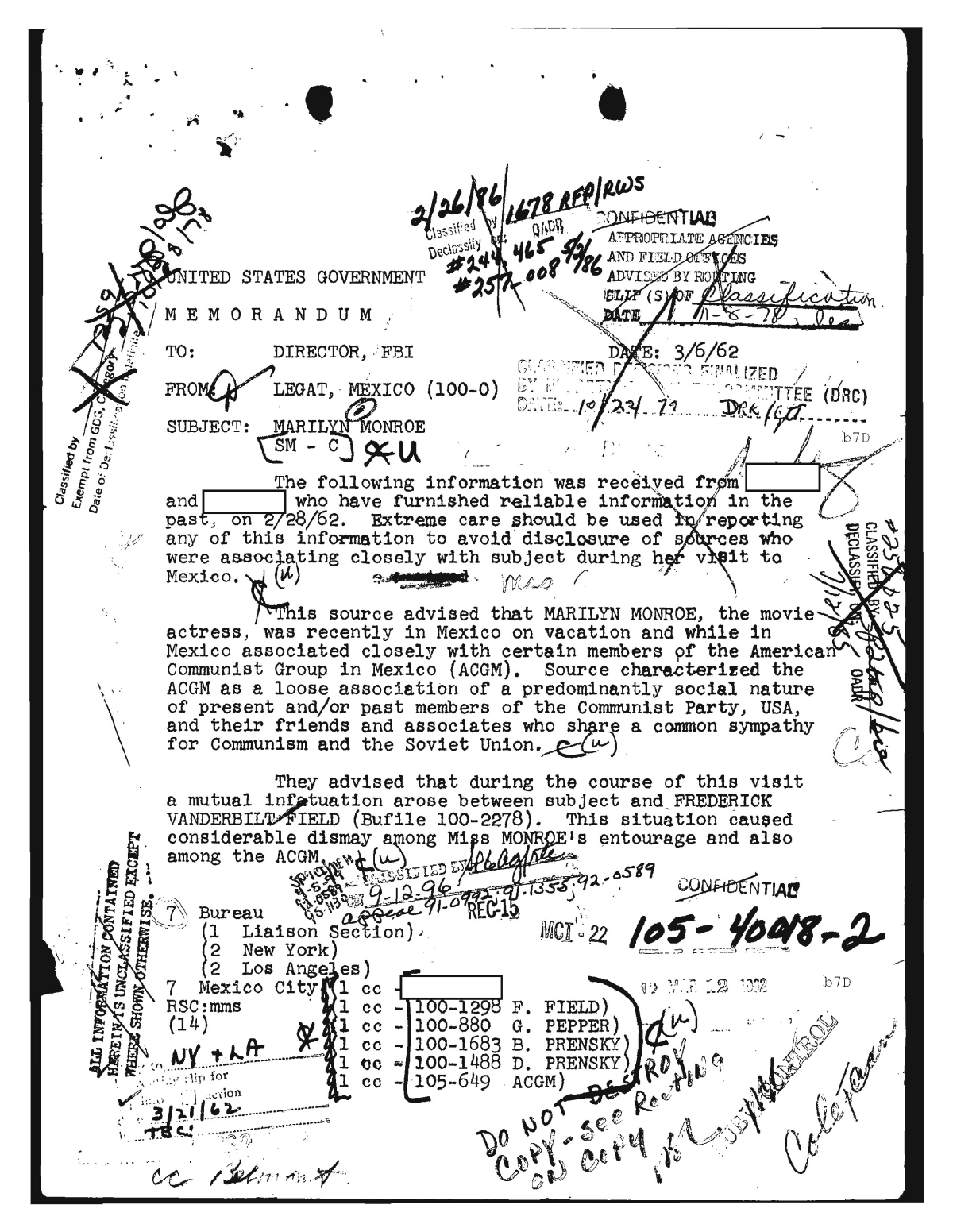


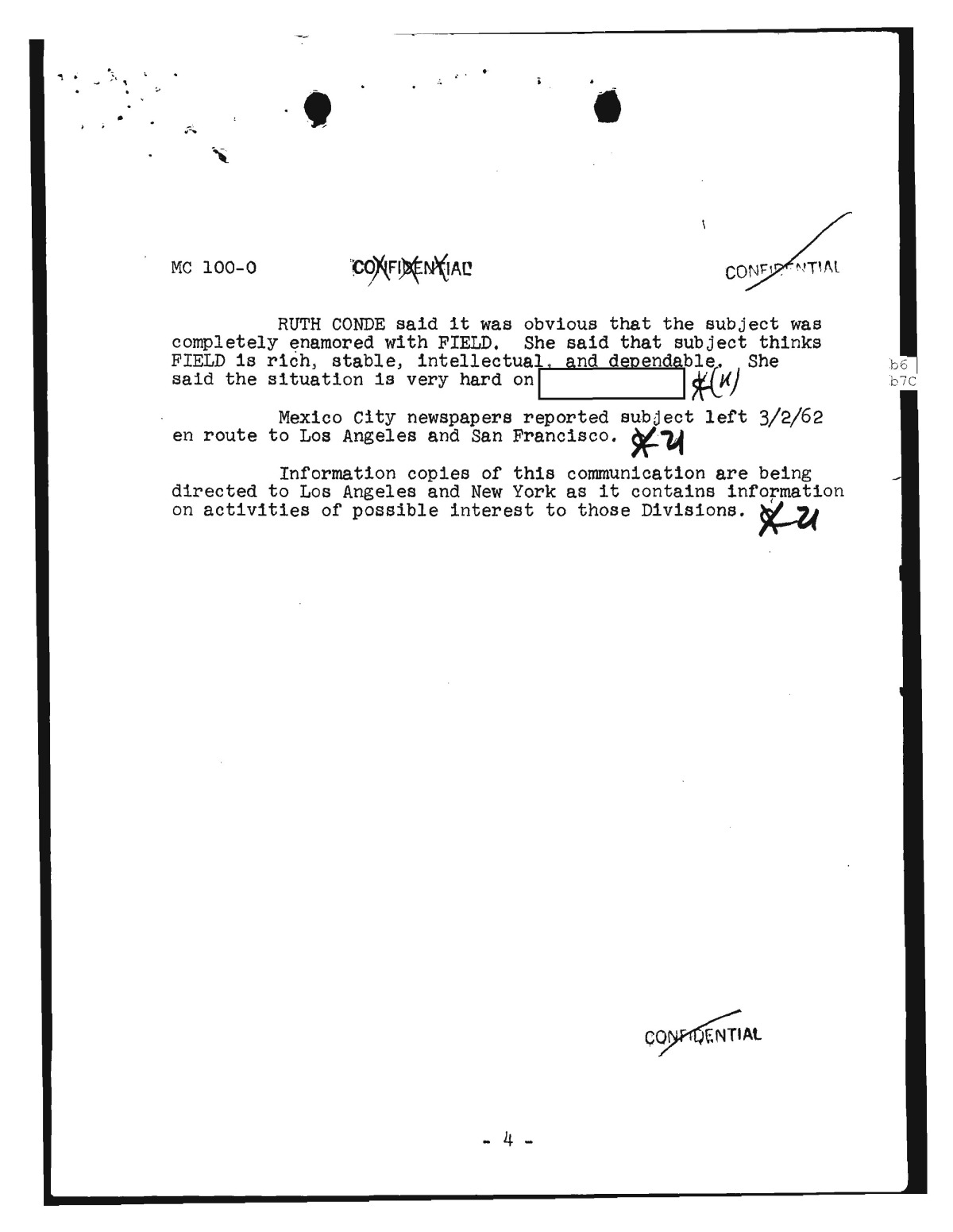
Written to the Director of the FBI from the Legat,2Legat is an FBI shorthand for Legal Attaché.Mexico, on subject, Marilyn Monroe, the memorandum reads as follows:
The following information was received from [redacted] and [redacted] who have furnished reliable information in the past, on 2/28/62. Extreme care should be used in reporting any of this information to avoid disclosure of sources who were associating closely with subject during her visit to Mexico.
The source advised that Marilyn Monroe, the movie actress, was recently in Mexico on vacation and while in Mexico associated closely with certain members of the American Communist Group in Mexico (ACGM). Source characterized the ACGM as a loose association of a predominantly social nature of present and/or past members of the Communist Party, USA, and their friends and associates who share a common sympathy for Communism and the Soviet Union.
They advised that during the course of this visit a mutual infatuation arose between subject and Frederick Vanderbilt Field (Bufile3Bufile, sometimes written BUFile or BU File, is an FBI shorthand for Bureau File, always followed by an associated file number.100-2278). This situation caused considerable dismay among Miss Monroe’s entourage and also among the ACGM.
On 2/21/62, Field visited subject in her suite (#1110) at the Hotel Continental Hilton at 5:00 P.M. The visit was arranged through New York friends and was based on his former friendship with Arthur Miller, her former husband. He stayed for about an hour and she agreed to go with Field on 2/23/62 to Toluca, Mexico, for the day.
Subject arrived in Mexico on 2/19/62 from Miami. Her entry into Mexico reportedly was arranged by Frank Sinatra through former President Miguel Aleman. She was accompanied by an agent [Pat Newcomb], a hair dresser [George Masters], and an interior decorator [Eunice Murray]. The latter was identified as Eunice Churchill, a widow about 65 from Los Angeles. Churchill said her husband was a violent trade unionist who was a functionary in the furniture workers section of the AF of L Carpenters Union who died four or five years ago. She identified him as a labor pioneer but did not identify him as a leftist. She is a part time interior decorator and also claims to be an assistant of Dr. Wexley, subject’s analyst.
According to Churchill, the subject was much disturbed by Arthur Miller’s marriage on 2/20/62 and feels like a negated sex symbol. Churchill said that subject has a lot of leftist rubbed off from Miller. Subject reportedly spent some time with Robert Kennedy at the home of the Peter Lawfords in Hollywood. Subject reportedly challenged Mr. Kennedy on some points proposed to her by Miller.
Subject was acquainted with Field’s background and principles and expressed curiosity as to his relationship with the Vanderbilt family.
On 2/24/62, subject traveled to Toluca, Mexico, to visit the native market. She was accompanied by Frederick Vanderbilt Field and [redacted]. Later they returned to the Field home and were joined by Bryna Prensky and her husband Henry David Prensky (Bufile 100-88237).
It became clear that a relationship was developing between subject and Field and considerable concern was expressed over this by members of the ACGM, such as May Brooks (Bufile 100-414864), Charles Smolikoff (Bufile 100-12632), and Ruth Conde, aka Ruth Ashmore Brown. Charles Smolikoff said that Field was completely infatuated with Monroe. Ruth Conde was very concerned for [redacted] who was excluded from a meeting of Field and subject on the night of 2/23/62.
On 2/25/62, Eunice Churchill said that Dr. Wexley did not like what was happening in the relationship between subject and Field and said that subject must get out with other people at once. She said subject is very vulnerable now because of her rejection by Arthur Miller and also by Joe Di Maggio [sic] and Frank Sinatra. She telephoned Sinatra to come and comfort her and he would not do it.
On the night of 2/24/62, she went with Field to a party at the home of Emilio Fernandez. [Lengthy redaction].
On 2/25/62, the subject had a date with George Pepper (Bufile 100-254107) to view the movie “Torrero” and go out with him afterwards; however, five minutes before he was to get her, she called and canceled the date and Pepper was furious.
Eunice Churchill continued to express concern over subject’s increasing dependence on Field.
On 2/27/62, subject attended a reception for Princess Antonio de Braganza, the Infanta of Portugal. This was given at the home of Dennis Bourke and was attended by the staffs of various embassies and was completely nonpolitical in nature.
It is noted that [lengthy redaction] throughout the evening she expressed considerable curiosity about Field.
On 2/28/62, subject was to leave on a two-day trip to Taxco, Mexico, accompanied by Frederick Vanderbilt Field and his wife [redacted].
Ruth Conde said it was obvious that the subject was completely enamored with Field. She said the subject thinks Field is rich, stable, intellectual and dependable. She said the situation is very hard on [redacted].
Mexico City newspapers reported subject left 3/2/62 en route to Los Angeles and San Francisco.
Information copies of this communication are being directed to Los Angeles and New York as it contains information on activities of possible interest to those Divisions.
Certainly an amazing report, to say the least. Considering the nature of the artisan criminals and pirates into whose league Marilyn had fallen south of the border, it is shocking that she was not arrested immediately upon her return to the United States and thereafter tried for treason and possibly hanged.
The constant use of the term subject to denote Marilyn within the report’s text, even though she was identified as Marilyn Monroe once, is interesting and certainly dehumanizing. The day to day accounting of her activities reads like a gossipy and sycophantic fan magazine, although on Monday, February the 26th, Marilyn must have needed a respite from her seditious activities: the report does not mention what she did on that date. We can assume that March the 1st, also not mentioned in the report, was the day during which Marilyn and her entourage prepared to leave Mexico, which they did on March the 2nd.
The errors contained in the memorandum are comic. The informant incorrectly identified Eunice Murray as Eunice Churchill. Apparently the informant confused Eunice with her brother-in-law, Churchill Murray, who was there and met Marilyn, that is unless Mrs. Murray lied about her identity. The fact that Mrs. Murray claimed to be a part time interior decorator was a revelation, as was invoking the name of Dr. Wexley, who was not a part of Marilyn’s entourage. The informant must have meant Dr. Milton Wexler, the therapist with whom Dr. Greenson, Marilyn’s psychiatrist, often consulted regarding the latter’s unorthodox treatment of his famous patient. Dr. Milton Wexler was not a part of Marilyn’s entourage, either; so the comment attributed to Dr. Wexley and his concern over Marilyn’s developing relationship with Field seems more than misplaced and exceptionally goofy.
Mrs. Murray reported to the informant that Marilyn felt like a negated sex symbol after she was rejected by Arthur Miller, Joe DiMaggio and Frank Sinatra, another oddity. Marilyn divorced Miller and the Mexican press questioned Marilyn about the rumors of her pending remarriage to Joe DiMaggio; and why would she telephone Sinatra, plead with him to come and comfort her? Certainly there were more than several men in Marilyn’s attendance during the trip who would have gladly provided her with some comfort, one named Jose Bolanos for instance. In his Marilyn biography, Gary Vitacco-Robles reported that Bolanos positioned himself with Mariachis beneath Marilyn’s balcony and serenaded her during her trip to Taxco, Mexico; and he also attempted to arrange a one-on-one meeting with Marilyn through Pat Newcomb. Bolanos followed Marilyn wherever she went. In recognition of Bolanos’ expressions of affection and adoration, Pat suggested to Marilyn that she would obtain more interesting publicity if the young and handsome, dashing Jose accompanied her to the Golden Globes Award Ceremony, to be held later that March, instead of her dumpy and married friend, gossip columnist Sydney Skolsky. When proposed to Bolanos, he immediately agreed to accompany Marilyn.
What I find the most curious and interesting of all is Eunice Murray’s alleged interaction with the FBI, considering how angrily Marilyn reacted when she learned about any unauthorized distribution of information about her personal life, any unauthorized invasion of her privacy, not to mention that Marilyn often expressed her disgust with the FBI and J. Edgar Hoover, no doubt borne out of Arthur Miller’s persecution by the HUAC in 1956. Additionally, Mrs. Murray’s characterization of her deceased husband as a violent trade unionist and the inclusion of Arthur Miller and Robert Kennedy within the text of this particular report seems almost gratuitous while its gossipy nature is certainly humorous.
When conspiracists invoke this 1962 report as an example of the security risk Marilyn had become by that year, they fail to mention one important detail: the source stated and defined the American Communist Group in Mexico as a loose association of persons whose affiliation was primarily social in nature even though they shared similar attitudes and sympathies for the Communist ideology, what Kurt Vonnegut would call a Granfalloon or a proud but otherwise meaningless association of persons. The reception to honor Antonio de Braganza, Infanta of Portugal,4Within the odd FBI report, there are several errors, one of which is invoking the name Princess Antonio de Braganza, Infanta of Portugal: that person did not exist. A Prince Antônio of Orléans Braganza would have been a twelve year old boy in 1962 and Infanta Antónia of Portugal, or Braganza, died in 1913. In ICON, Gary Vitacco-Robles suggested that the informant actually meant Anita de Braganza, an American socialite and heiress born Anita Stewart Morris. She married Dom Miguel of Braganza, Infante of Portugal, Duke of Viseu, in Dingwall Castle, Scotland, in September of 1909. In 1962, Anita, the Princess of Braganza, would have been seventy-five years old. Even though Mr. Vitacco-Robles is probably correct, Anita’s obituary, which appeared in the New York Times on September the 17th in 1977 did not indicate any residency in Mexico during her lifetime nor that she had ever traveled to that country. Anita was ninety-one years old when she died in New Port, Rhode Island.for instance, was described as completely nonpolitical in nature even though diplomats and staff members of several embassies attended the party. Other FBI memoranda and reports would note that the pernicious Mexican Communist Group was virtually a toothless paper Tiger which lacked organization and influence, particularly in America. I hasten to note that the Mexican press followed Marilyn and her entourage throughout her trip and reported on her activities religiously. Many articles appeared in Mexican newspapers as well as newspapers north of the border. That the FBI report served any purpose at all, other than gossip mongering, is certainly a legitimate topic for debate.
Even in 1963, Hoover’s agents were still reconnoitering that evil and seditious Communist, Marilyn Monroe. A memorandum to Mr. DeLoach from M. A. Jones, dated the 9th of July, generally described an article written by Walter Winchell that is about another article which had appeared in Photoplay magazine. Winchell claimed in his article that the Photoplay article practically names the married man who has children and who “killed” Marilyn. Jones disputed Winchell’s claim:
[…] the article comes noway [sic] near identifying anyone. The article states that she telephoned the man on Sunday night, August 5, 1962, and when he said he would not leave his wife and could not see Miss Monroe ‘any more’ [sic] she swallowed a ‘handful’ of sleeping pills. The article claims she later called the man again, implying that she told him of having taken the pills, only to have him hang up on her and states that the last sound she heard was the ‘buzzing of the receiver in her hand’ after the man broke the telephone connection.
For some strange reason, Mr. Jones felt compelled to write a report about two ridiculous articles written about Marilyn almost one year after her death. I find that to be more than strange and goofy and the report contains one glaring and obvious factual error: Marilyn was already dead by Sunday night, August the 5th. Also, how could anyone know the contents of any conversation Marilyn had the night of her death or the last sound she actually heard unless they were on the other end of the telephone line. Oh, that’s right: they heard the secret tapes. Remarkably enough, the President of the United States would be assassinated in just six short months. Maybe the energies of the FBI should have been focused on something other than a deceased Marilyn Monroe; and even though Mr. Jones wrote a report about the two articles, the FBI did not even investigate the claims made by Photoplay or Walter Winchell.
On July the 23rd in 1973, T.J. Smith wrote a memorandum to E.S. Miller regarding Norman Mailer’s literary effort, Marilyn: A Biography. Once again, before providing a transcription of the file, the actual FBI files follow hereafter:

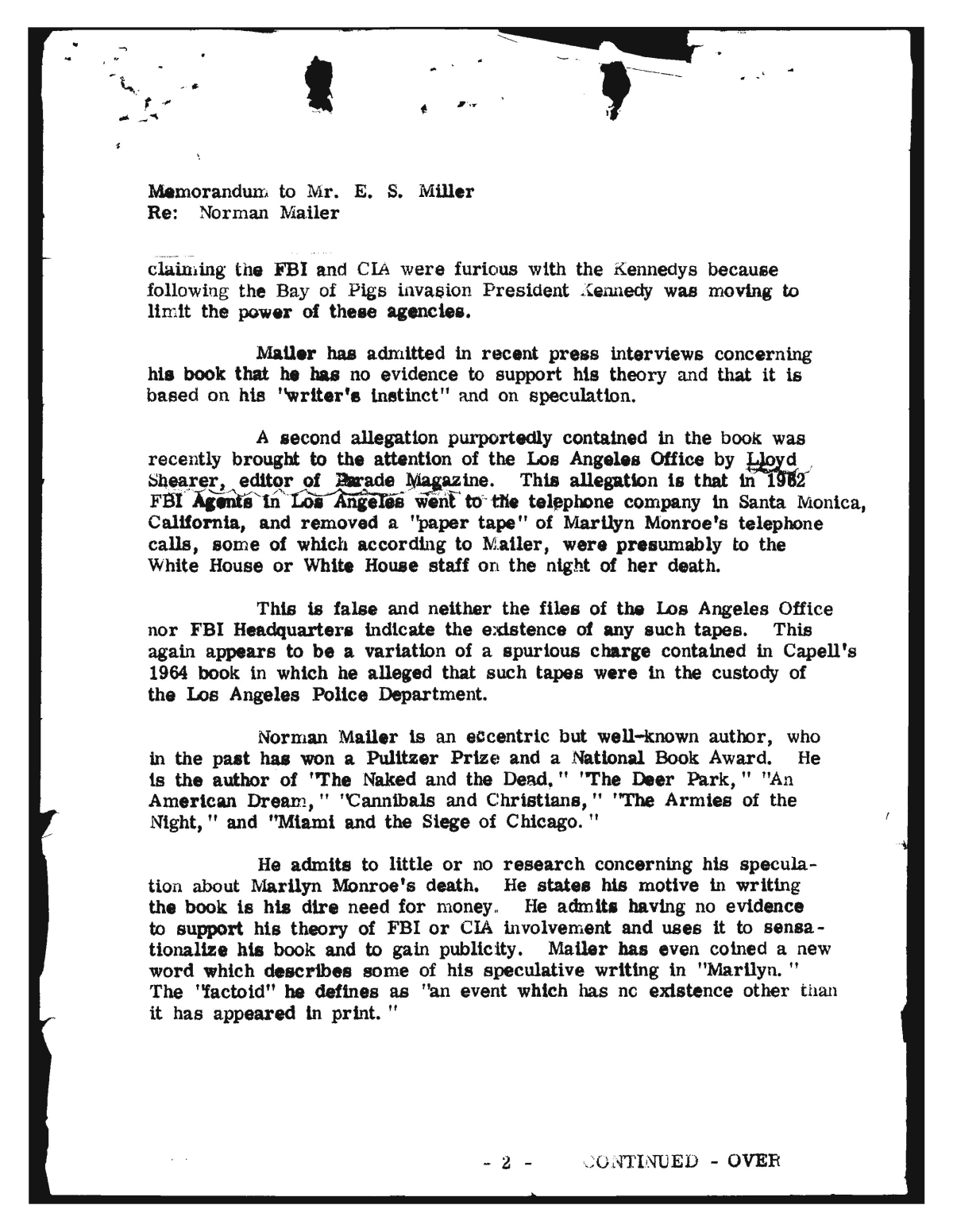
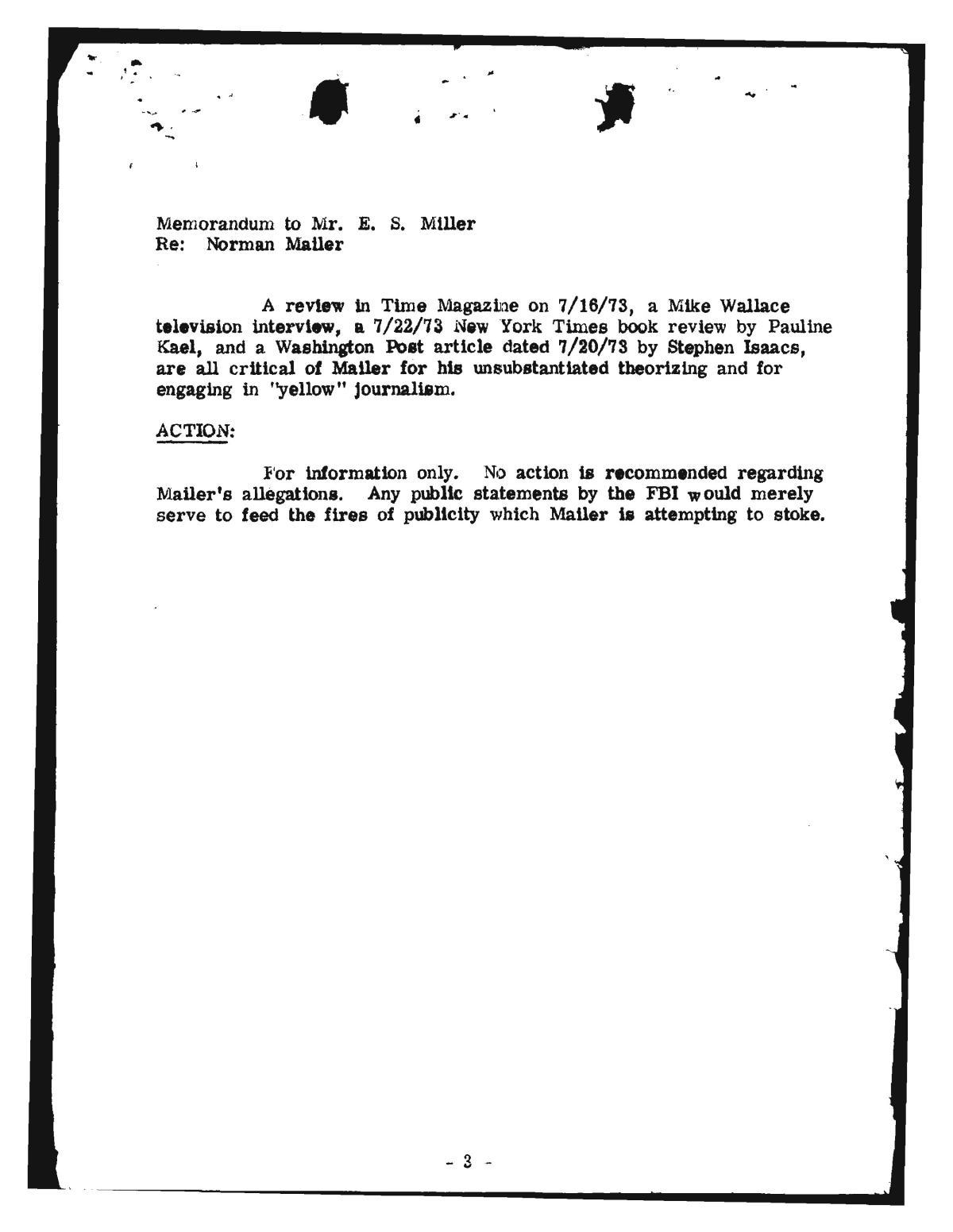
The purpose of Smith’s memorandum was:
To advise of speculation concerning FBI complicity in the death of Marilyn Monroe propounded by author Norman Mailer in his soon-to-be-published biography of the deceased actress […].
Following Miss Monroe’s death by drug overdose in 1962, there was a spate of rumors, originating on the West Coast, alleging she was having an affair with the then attorney General Robert F. Kennedy and that her death was in some way related to this and/or was the result of a plot revolving around some of her associates who allegedly had past Communist Party affiliations or sympathies. These rumors were embellished upon at the time in various sensational-type gossip magazines and in a short book published by Frank A. Capell. These allegations were branded false and no support existed for them.
Mailer, in his new book, has repeated some of these same rumors and has given them a bizarre twist.
As to whether Miss Monroe took her own life, Mailer answers possibly―and then suggests other possibilities. One of these is the suggestion that the FBI, CIA or the Mafia found it of interest that Robert Kennedy, brother of President John Kennedy, was reputed to be having an affair with the movie star. Mailer suggests that right-wing FBI and CIA Agents had a huge motivation to murder Marilyn Monroe in order to embarrass the Kennedy family, claiming the FBI and CIA were furious with the Kennedys because following the Bay of Pigs invasion President Kennedy was moving to limit the power of these agencies.
Mailer has admitted in recent press interviews concerning his book that he has no evidence to support his theory and that it is based on his writer’s instinct and on speculation.
A second allegation purportedly contained in the book was recently brought to the attention of the Los Angeles Office by Lloyd Shearer, editor of Parade Magazine. This allegation is that in 1962, FBI agents in Los Angeles went to the telephone company in Santa Monica, California, and removed a paper tape of Marilyn Monroe’s telephone calls, some of which according to Mailer, were presumably to the White House or White House staff on the night of her death.
This is false and neither the files of the Los Angeles Office nor FBI Headquarters indicate the existence of any such tapes. This again appears to be a variation of a spurious charge contained in [Frank] Capell’s 1964 book [The Strange Death of Marilyn Monroe] in which he alleged that such tapes were in the custody of the Los Angeles Police Department.
Norman Mailer is an eccentric but well-known author, who in the past has won a Pulitzer Prize and a National Book Award. He is the author of “The Naked and the Dead,” “The Deer Park,” “An American Dream,” “Cannibals and Christmas,” “The Armies of the Night,” and “Miami and the Siege of Chicago.”
He admits to little of no research concerning his speculation regarding Marilyn Monroe’s death. He admits his motive for writing the book is his dire need for money. He admits having no evidence to support his theory of FBI or CIA involvement and uses it to sensationalize his book and to gain publicity. Mailer has even coined a new word which describes some of his speculative writing in “Marilyn.” The “Factoid” he defines as an event which has no evidence other than it has appeared in print.
A review in Time Magazine on 7/16/73, a Mike Wallace television interview, a 7/22/73 New York Times book review by Pauline Kael, and a Washington Post article dated 7/20/73 by Stephen Isaacs, are all critical of Mailer for his unsubstantiated theorizing and for engaging in yellow journalism.
ACTION:
For information only. No action is recommended regarding Mailer’s allegations. Any public statements by the FBI would merely serve to feed the fires of publicity which Mailer is attempting to stoke.
Obviously, the FBI was not concerned about Mailer’s factoidal book; and the preceding report completely dismissed Frank Capell’s 1964 politically motivated pamphlet. And just as obvious, T.J. Smith understood that Mailer was merely seeking sensationalism, which an investigation into Mailer’s accusations would have provided. Smith knew that Mailer’s novel biographical novel was simply baseless.


